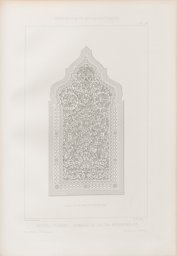The main text and the illustrations of Architecture et décoration turque au XVe siècle, published 1874 in Paris, are by Léon Parvillée. The preface is written by his former teacher Eugène Viollet-le-Duc.
The text gives a historical overview of early Ottoman Bursa and its monuments, and the origins and methods of Turkish art (‘l’art turc’), as well as its principles of layout and use of colour. In the illustration section, most of the figures are connected to the Yeşil Cami (Green Mosque) and the Yeşil Türbe (Green Tomb). Out of 48 pages in the illustration section, 41 are dedicated to architectural décor, while the other 7 pages show interior or exterior views, elevations, and ground plans. The figures include two full-page illustrations of stucco and glass windows, yet Parvillée does not mention them in the text.


